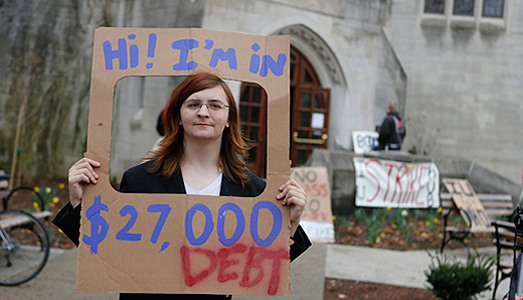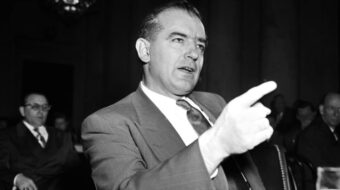
A major issue for college students in the 2012 presidential campaign was the possibility that interest rates on federal subsidized Stafford loans would double from 3.4 percent to 6.8 percent on July 1, 2012. With student debt hitting $1 trillion and becoming the second largest form of consumer debt, a doubling of interest rates would only further harm struggling students and negatively impact the economy.
To remedy this potential problem, President Obama – with bipartisan support – proposed an extension of the 3.4 percent rate for one year. After a one-year reprieve, interest rate hikes for those in the Stafford loan program are again staring lower and middle class students dead in the face. This time around, however, the only proposed solutions will increase student debt.
College students and graduates currently have limited options to address the debt issue: let the one-year extension expire on July 1, 2013 and see interest rates double; accept plans to further delay rate hikes; or accept the president’s proposal to tie student loan interest rates to market conditions, which would effectively raise student loan interest rates as the economy recovers.
With consensus on a long-term solution far off in Washington D.C., both the House and the Senate have proposed plans to delay the rate hike for two years or indefinitely postpone it. If the government cannot come up with a long-term solution, skyrocketing student debt will continue to adversely affect students across the country, including here in the Pennsylvania State System of Higher Education (PASSHE),
According to the Project on Student Debt, two-thirds of graduating students in the United States in 2011 had an average debt of $26,600. Seventy-seven percent of students graduating from PASSHE universities in 2011 took on student loans; the average student graduated with $26,047 in student loan debt, with an estimated $20,727 coming from federal student loan programs. Students are graduating with significant debt, and allowing rates to double will only make matters worse.
Let’s assume a student graduates with $10,000 in subsidized Stafford loan debt. If interest rates were to double, that student would pay an extra $2,000 in interest over the life of their 10-year loan. While this scenario may be frightening, the proposed solutions may end up being worse.
In President Obama’s budget request on April 10, the president proposed changes to the way interest rates are calculated for subsidized and unsubsidized Stafford loans, as well as Parent PLUS loans. The president’s “market-based solution” would peg the interest rate on these loans to the current 10-year bond rate plus an additional amount for each loan type. Inside Higher Ed describes how these formulas would apply:
“The interest rate would be the 10-year Treasury yield plus 0.93 percent for subsidized Stafford loans, plus 2.93 percent for unsubsidized Stafford loans, and plus 3.93 percent for PLUS loans for parents and graduate students.”
The logic behind the proposal is that students will graduate with low interest rates during hard economic times and higher rates when the market is healthier. However, what looks to be a short-term win for prospective and current college students and recent graduates can actually turn into a Trojan Horse years down the line.
Considering that current interest rates for unsubsidized Stafford loans are 6.8 percent, Parent PLUS is 7.9 percent and the 10-year Treasury yield is at 1.84 percent, this formula would be a benefit for parents and students at the present moment. But when the economy picks up again, parents and students will most likely be paying more money for interest for all three government loans. In the years leading up to the recession, 10-year interest rates peaked at around 6.6 percent in 2000 and hovered around 4.5 to 5.25 percent in the immediate run-up to the recession. If the economy fully recovers, students will be facing interest rates that may be much higher than current rates. Using the formula quoted above, if 10-year treasury rates were between 4.5 and 5.25 percent, subsidized Stafford loan rates would be between 5.43 and 6.18 percent, unsubsidized Stafford loan rates would be between 7.43 and 8.18 percent, and parent PLUS loans would be between 8.43 and 9.21 percent. If Treasury rates returned to their pre-recession peak, interest rates would be even higher.
With the economy still “depressed” and student debt at an all-time high, policymakers and students should be discussing reforms to the way interest rates are calculated. These reforms should focus on long-term affordability and accessibility.
Education advocates worry about the government using these loans, which serve lower and middle class families, as means to generate long-term profits. ThinkProgress noted that the federal government is set to make $34 billion off of student loans in 2014, and the government makes 12.5 cents on every subsidized Stafford loan dollar. Nearly two-thirds of those in the Stafford loan program are from families with an annual income under $50,000. Education advocate Ethan Senack said, “[H]igher education loans are meant to subsidize the cost of higher education, not profit from them, especially at a time when students are facing record debt.” Tying interest rates to market conditions, while possibly providing short-term relief, may be counter to this mission in the long run. Students should demand more lasting, meaningful reform.
Sean Kitchen is assistant editor of Raging Chicken Press, a small activist, progressive publication in Kutztown, Pa.
Photo: Indiana University senior holds a sign that represents the average debt a college student has after graduating, during a IU protest, April 11, in Bloomington, Ind. Jeremy Hogan/Bloomington Herald-Times/AP










